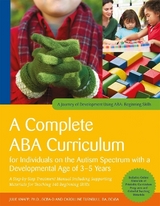
A Complete ABA Curriculum for Individuals on the Autism Spectrum with a Developmental Age of 3-5 Years
Jessica Kingsley Publishers (Verlag)
978-1-84905-979-4 (ISBN)
- Titel ist leider vergriffen;
keine Neuauflage - Artikel merken
Containing everything needed to teach beginning skills such as imitation, visual spatial awareness, expressive and receptive language skills and skills of daily living, this comprehensive ABA curriculum has been developed for individuals on the autism spectrum with a developmental age of approximately 3-5 years.
Evidence-based, the resource guides instructors step-by-step through using ABA to teach over 140 beginning skills. The program can be individualized to meet the needs and interests of the individual, and instructions are given on how to do this. The accompanying CD contains the teaching materials needed to implement the program, including over 1000 color picture cards, handy printable copies of the curriculum programs, data forms and checklists. The authors also provide guidance on creating an effective ABA teaching environment, as well as a wealth of practical teaching strategies for ensuring therapy success.
This is an unparalleled resource for professionals working with children with ASDs who are looking for a robust and ready-to-implement ABA curriculum. It will be a valuable tool for behaviour analysts, teachers, psychologists, occupational therapists and students in these fields, as well as to parents working with professionals to implement an ABA program.
Dr. Julie Knapp, Ph.D., BCBA-D is a Pediatric Neuropsychologist and Board Certified Behavior Analyst-Doctorate. She is Executive Director of the Knapp Center for Childhood Development located in Boardman, OH, which specializes in the diagnosis, neuropsychological assessment and treatment of children with autism spectrum disorders. Dr. Knapp offers an International ABA Program assisting families from other parts of the world to travel to the US for ABA therapy. She offers remote training and supervision on ABA programs through a HIPPA secure website to families across the world who otherwise cannot find local ABA therapy or who want expert advice on their program. Dr. Knapp is also a Consultant at University Hospitals Rainbow Babies and Children's Hospital and holds an appointment at Case Western Reserve University. Carolline Turnbull, BA, BCaBA is a Board Certified Associate Behavior Analyst at KidsLink Neurobehavioral Center in Twinsburg, OH. Carolline is a behavior consultant for home and school-based consultation and developed a dance class for children ages 3-6 with varying disabilities and their neurotypical peers. She completed her Bachelor's degree in speech pathology and audiology at Kent State University and her course work for her BCaBA at Florida Institute of Technology. Carolline has worked in the area of behavioral management of children and young adults with developmental disabilities for 15 years.
Acknowledgments. About the Author. 1. Introduction to ABA Curriculum. 2. Curriculum Guide. 3. ABA Curriculum - Understanding the Task Analyses in this Program. 4. ABA Curriculum - Implementing the Task Analyses in this Program. 5. Teaching Strategies. 6. Data Collection and Data Recording. 7. Graphing. 8. Creating an ABA Environment. Curriculum Programs. 9. Attending Programs. Appropriate Sitting during a Family Meal; Appropriate Sitting during a School Activity; Sustained Eye Contact. 10. Imitation Programs. Complex Fine Motor Imitation; Complex Fine Motor Imitation with Objects; Complex Gross Motor Imitation; Complex Gross Motor Imitation with Objects; Imitation: Mirror-Speed-Intensity-Sequence; Pretend Actions Imitation (no objects used). 11. Visual Spatial Programs. Arrange by Series or Sequence; Building Block Formations, Extending Sequence Patterns; Matching Block Formations to Pictures of Block Formations; Matching Object Association; Matching Uppercase to Lowercase Letters; Matching Lowercase to Uppercase Letters; Mazes; Puzzles (Square Boarder and Jigsaw); Sorting Objects by Feature; Sorting Pictures by Feature; Sorting Objects by Function; Sorting Pictures by Function, What Doesn't Belong?12. Receptive Language Programs. Discriminating Sounds; Makes a Choice; Past Tense Verbs; Irregular Past Tense Verbs; Plurals; Irregular Plurals; Pronouns (He/She); Pronouns (His/Hers); Pronouns (I/You); Pronouns (My/Your); Pronouns (Their/Ours); Pronouns (We/They); Receptive Instructions Delivered In a Group; Receptive Instructions (Two Step); Receptive Labels of Attributes; Receptive Labels of Categories; Receptive Labels of Community Helpers; Receptive Labels of Emotions; Receptive Labels of Function of Body Parts; Receptive Labels of Function of Objects; Receptive Labels of Gender; Receptive Labels of Rooms and Objects in a Room. 13. Expressive Language Programs. Answer Simple “What” Questions; Answer Simple “When” Questions; Answer Simple “Where” Questions; Answer Simple “Where” Questions about a Classroom; Answer Simple “Which” Questions; Answer Simple “Who” Questions; Answer Simple Yes/No Questions; Answer Social Questions; Describes Pictures; Discriminating Sounds; Expanding Sentence Length (Action-Object); Expanding Sentence Length (Subject-Action); Expanding Sentence Length (Subject-Action-Object); Expanding Sentence Length (Subject-Object); Expanding Sentence Starters; Expressing Displeasure; Expressive Labels of Attributes; Expressive Labels of Categories; Expressive Labels of Community Helpers; Expressive Labels of Emotions; Expressive Labels of Function of Body Parts; Expressive Labels of Function of Objects; Expressive Labels of Gender; Expressive Labels of Rooms and Objects in a Room; Intraverbal Fill-Ins of Predictable Routines; Manners; Past Tense Verbs; Irregular Past Tense Verbs; Plurals; Irregular Plurals; Pronouns (He/She); Pronouns (His/Him/Hers); Pronouns (I/You); Pronouns (My/Your); Pronouns (Their/Ours); Pronouns (We/They); Provides Simple Directions to Another; Reciprocates Information; Requests Needed or Missing Materials; Simple Requests Using Questions; Simple Requests Using Sentences; Verbal Imitation of Phrases. 14. Academic Programs. Connect the Dots; Cutting; Expressive Labels of 3-Dimensional Shapes; Expressive Labels of Beginning Sounds of Letters; Expressive Labels of Money; Expressive Labels of Opposites; Folds Paper; Part/Whole Relationships; Painting; Pasting and Gluing; Quantitative Concepts; Receptive Labels of 3-Dimensional Shapes; Receptive Labels of Beginning Sounds of Letters; Receptive Labels of Money; Receptive Labels of Opposites; Reading: Matching Letter Sounds to Pictures; Reading: Matching Words to Pictures; Rhyming; Task Duration. 15. Play/Social Programs. Duck Duck Goose; Independent Play via a Play Schedule; Participation in Complex Childhood Songs & Games; Playground: Ladder; Playground: Merry Go Round; Playground: Monkey Bars; Playground: Sliding Board; Playground: Swing; Playground: Teeter Totter; Playground: Tunnel; Pretend Play: Birthday Party; Pretend Play: Detective; Pretend Play: Doctor; Pretend Play: Kitchen; Pretend Play: Mommy & Daddy; Pretend Play: School; Pretend Play (No Props); Pretend Play: Same Role – Dancers; Pretend Play: Same Role – Pirates; Pretend Play: Same Role – Princesses; Pretend Play: Same Role – Race Car Driver; Pretend Play: Same Role – Train Engineers; Swimming: Level 1; Symbolic Play; Turn-Taking. 16. Adaptive Skills Programs. Applying Chap Stick; Buttoning and Unbuttoning; Cleans Ears; Dressing and Undressing: Putting on and Taking Off Gloves; Dressing and Undressing: Putting on and Taking off Gym Clothes; Snapping and Unsnapping; Systematic Desensitization: Brushing Hair; Systematic Desensitization: Brushing Teeth; Unzips a Zipper; Waiting; Walks Backwards; Wipes Hands and Face; Zips a Connected and Unconnected Zipper. References. Index.
| Erscheint lt. Verlag | 10.6.2014 |
|---|---|
| Reihe/Serie | A Journey of Development Using ABA |
| Verlagsort | London |
| Sprache | englisch |
| Maße | 214 x 279 mm |
| Gewicht | 1258 g |
| Themenwelt | Sozialwissenschaften ► Pädagogik ► Schulpädagogik / Grundschule |
| Sozialwissenschaften ► Pädagogik ► Sonder-, Heil- und Förderpädagogik | |
| Sozialwissenschaften ► Pädagogik ► Vorschulpädagogik | |
| ISBN-10 | 1-84905-979-9 / 1849059799 |
| ISBN-13 | 978-1-84905-979-4 / 9781849059794 |
| Zustand | Neuware |
| Haben Sie eine Frage zum Produkt? |
aus dem Bereich



